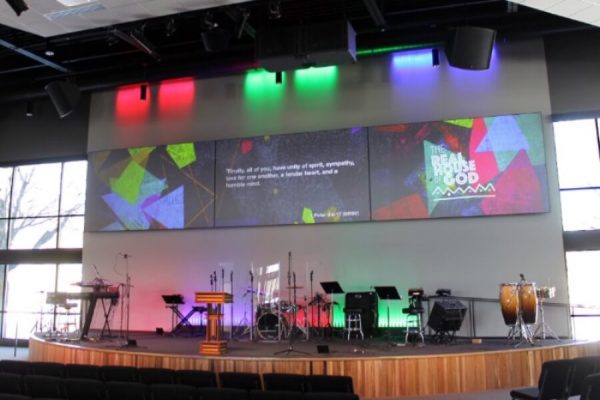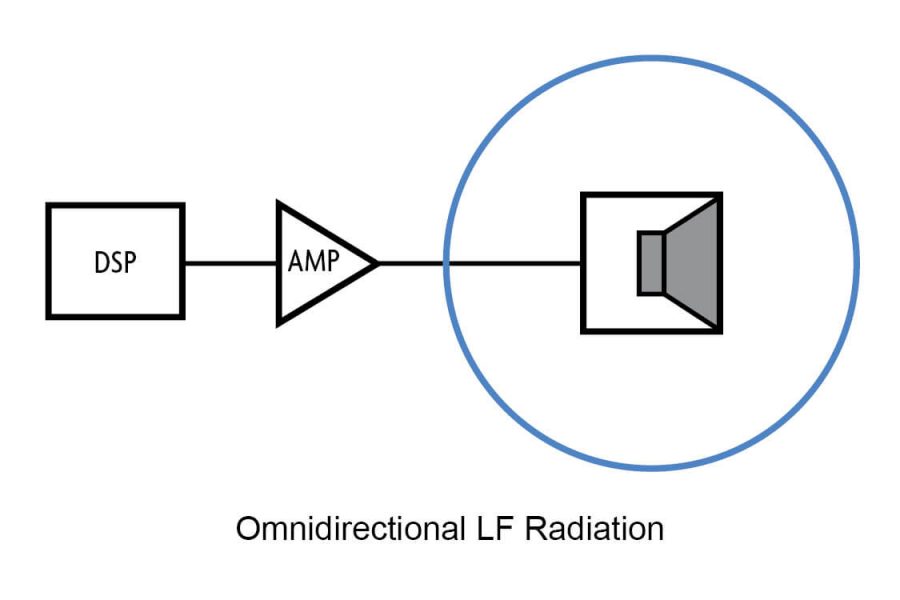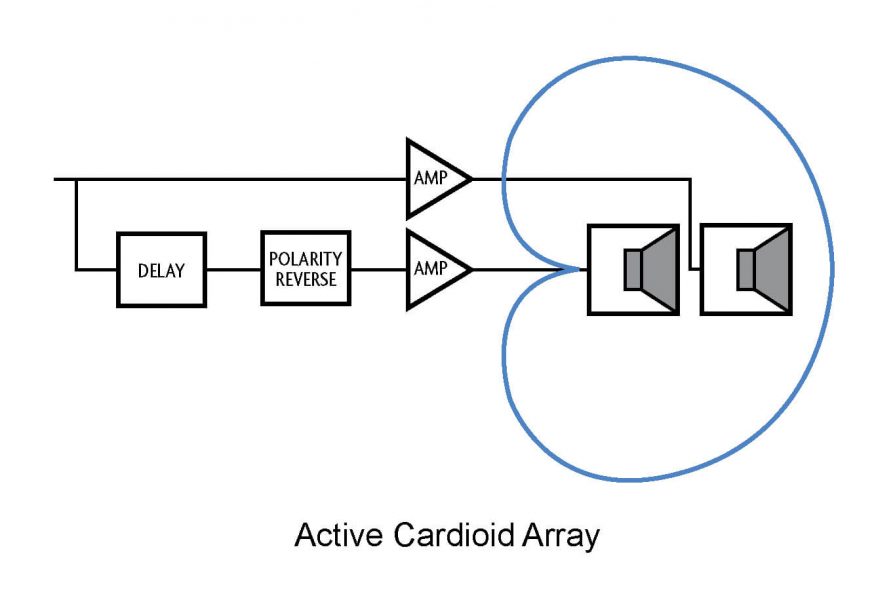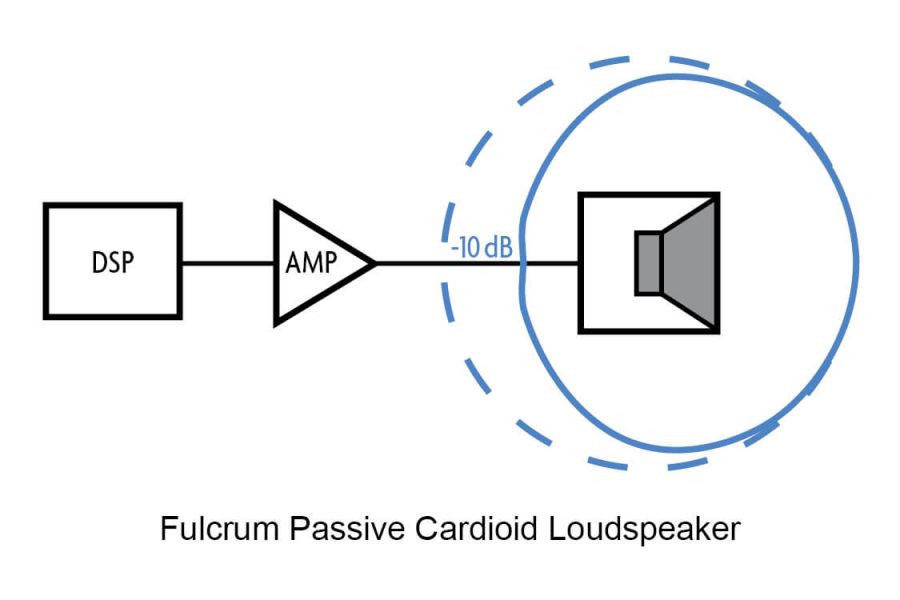Controlling Subwoofers
Before we look at controlling subwoofers, it’s essential to understand what a subwoofer is: a loudspeaker dedicated to the reproduction of low-pitched audio bass and sub-bass frequencies, intended to augment the lower end range of loudspeakers systems. In other words, subwoofers provide the “thump” or the part of sound that you “feel.”
Bass frequencies are typically below 250 Hz, with sub-bass in the 20 – 100 Hz range. The accepted hearing range for people is commonly stated to be between 20 to 20,000 Hz, although we tend to be less likely to hear the full range of frequency below 100 Hz, which is why sub-bass amplification is needed to round out the full range of sound. There is also considerable variation in what frequency ranges can be best heard on an individual level (due to age and other factors), so while it’s factual to state a 20 to 20,000 Hz hearing range, in actuality it’s not that simple.

Two Fulcrum Acoustic US221-4 Dual 21 inch Direct-Radiating Subwoofers flown centerstage at Sanctuary Covenant Church, Minneapolis, MN
Subwoofer placement plays an important role in how low-end frequencies are delivered into a listening space, which means, in many cases, less is more. While having a lot of subwoofers to deliver the thump might seem like a good idea, all too often it is overkill, maybe even detrimental. Below are some subwoofer placement options:Back in the day when the majority of houses of worship relied solely on organ, piano and acoustic instruments during worship, the need for the sound system to reproduce deep bass wasn’t a big deal because nobody expected it. While audio has always been paramount, the focus was almost always on the spoken word; it was rare indeed for instruments to be amplified at all. In the last thirty years, this has changed and audience expectations have shifted. The introduction of contemporary worship bands, powered instruments, mic’d singers and drumkits elevated the need for sound systems that could ably handle both spoken and more modern music styles, as well as support multimedia. The way people listen to music has also changed – at concerts, through high-performance headsets and ear-buds – the need to encapsulate a full range of acoustic frequencies has become paramount. No matter the venue, or the audience, people expect to hear sound a certain way: the kick of the bass drum, the sound of a bass guitar, or the low-frequency rumble that can be felt in your chest are all key parts of making things sound correct or complete.
Left/Right
Subs can be, and often are, placed to the left and right of the stage, either on the ground or flown. This is probably because they are supporting a left/right sound system, or because that is the most convenient physical place to put them. When spacing subwoofers to the left and right, the length of the sound waves they are reproducing needs to be taken into consideration. Since their sound wavelengths are very long, some of the bass frequencies can couple (add together) in the center of the room and create more of that frequency, while other frequencies will cancel each other out. This can make for a very irregular sub-bass volume pattern as you move from side to side within the room. Additionally, sound system designers often are told where they are allowed to put subwoofers to ensure their placement does not detract from the aesthetic of the worship environment. Understanding how subwoofers impact each other is key in these situations.
Center
Placing subs in a center location, either on the ground or flown, allows for a more even radiation into the listening area. It is generally the best compromise for good radiation into the room and the most budget friendly approach. When placed in the center, sometimes, too much low frequency may wash back onto the stage. Because of this, we will want to deploy high pass filters on vocal microphones and maybe consider other ways, such as directional subwoofers and subwoofer arrays, to control the sub radiation onto the stage for a clearer and cleaner reinforced sound.
Spaced Horizontal Array
Spacing a number of subwoofers across the front of your stage narrows the horizontal radiation pattern, but still allows for a nice low-frequency wash into the room. This design is usually a compromise of trying to get uniform sound distribution while concealing the subwoofers into the stage architecture. This approach can be very effective for keeping the stage clean, but subwoofer tuning should be carefully considered to best utilize the interaction of multiple subwoofers.
Distributed
Sometimes in very large or very wide spaces, subwoofers might need to be added in the “more remote” listening area. In these cases, digital signal processing should be deployed to help ensure the sound from these subs is delayed and the levels are in sync with the sound coming from the main loudspeaker system.
With any of these placement options, subwoofers (or subwoofer systems) with more pattern control will help keep the sub energy where you want it and not everywhere else. Subwoofers are generally omnidirectional. They radiate about the same sound output all the way around the loudspeaker. This omnidirectional radiation tends to put sub energy everywhere and “muddies” up the full-range part of the sound in the listening area. There are several options for directional subwoofers that “turn down” the radiation behind the subwoofer. You can also build arrays of subwoofers that can help control the pattern if you have the space and budget to do so. A directional subwoofer system helps deliver sub impact to the listeners, while limiting the sub energy on the stage, into open microphones, and other areas where you don’t want it.
A qualified designer and integrator/installer will be able to work with you and your church on delivering the best fit for your performance and budget needs. This is imperative: you want good bass coverage that will be consistent throughout your worship space.

Fulcrum Acoustic’s innovative Passive Cardioid Technology™ was developed to overcome excessive rear low-frequency (LF) radiation, a performance challenge for many loudspeakers. As audio frequency decreases into the bass and sub-bass ranges, audio output becomes less directional. This causes the sound radiating to the rear of the loudspeaker to be approximately equal to the sound radiated toward the audience.

Active cardioid arrays are often employed to address undesired rear LF radiation. By requiring additional cancellation loudspeakers, and their associated amplifiers and signal processors, active cardioid arrays are intrinsically cumbersome and costly. For houses of worship with limited space and budget, they may not be a viable solution.

Fulcrum Acoustic’s Passive Cardioid Technology eliminates excessive rear LF radiation without the associated costs and space requirements of active cardioid systems, allowing a single passive cardioid speaker to do the work of an active cardioid array. Fulcrum passive cardioid loudspeakers produce high sound pressure in the forward direction and consistent attenuation in the rearward direction without additional amplifiers, drivers and signal processors. This allows for impressive LF directional control mechanically within the enclosure in less than half the space required for active cardioid subwoofer array systems. Fulcrum’s single-amplified, passive cardioid subwoofers also deliver system cost benefits over traditional bi-amplified active cardioid arrays.

By using only one DSP channel and one amplifier channel to create the subcardioid pattern, Fulcrum Acoustic is able to lower the cost of the speaker while creating a cleaner sound in the back with better control over the shape of the polar response. In other words, passive cardioid can create the same output of an active cardioid speaker with half as many drivers, half as much amplifier power and a smaller enclosure. And – since passive cardioid loudspeakers only use one cone, there is less concern of potential distortions that are typically present in two-cone active cardioid speakers.

